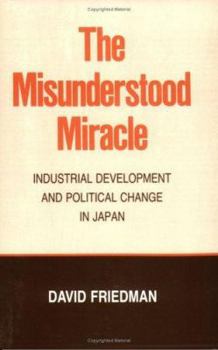The Misunderstood Miracle: Myth and Ritual Among Nepal's Tamang
(Part of the Cornell Studies in Political Economy Series)
Select Format
Select Condition 
Book Overview
This book addresses the reasons for the spectacular growth of Japanese manufacturing industries in the period beginning with the mid-1950s and ending in the late 1970s. Clean, tight book. 264pp.... This description may be from another edition of this product.
Format:Paperback
Language:English
ISBN:0801494796
ISBN13:9780801494796
Release Date:January 1988
Publisher:Cornell University Press
Length:265 Pages
Weight:0.90 lbs.
Customer Reviews
2 ratings
Many Possible Paths to Development.
Published by Thriftbooks.com User , 17 years ago
As Friedman points out, Japan's rise from postwar devastation to the first ranks of industrial nations has stimulated two rival explanations. One, the "market regulation hypothesis," claims Japan actually owes its success to playing the development game by the book. The other, "bureaucrat regulation hypothesis," claims that Japan's civil service applied a brilliant industrial policy to achieve the desired results. Friedman briefly but cogently outlines the implications of either theory, including logical problems with both. He then proceeds to deduce another hypothesis yet. His method is exciting because it demonstrates how statistical analysis and historical research can come together to make a rigorous, compelling case. Friedman's approach is highly scientific and deductive, and yet very easy for non-specialists to follow. Focusing on the specific case of Japan's machine-tool industry, he demonstrates the gradual evolution of industrial policy methods from 1925 to the mid-70's. For decades Japan's famous MITI sought to make the country's industries competitive by consolidating the huge number of tiny, regional machine shops into one big "modern" firm. Instead, MITI was thwarted; often its policies achieved the opposite of what was intended. Friedman introduces the politics of industrial relations, and how the "political" relationships between categories of producers, and towards the Japanese state, helped shape Japanese industry into its contemporary mix of strengths and weaknesses. The amazing resilience and aptitude of the small Japanese firm is shown to be a source of strength and flexibility. This is actually a fairly short book, and yet it is packed with very creative, enlightening ideas. I was especially impressed with his detailed accounts of wartime Japan and the role of *zaibatsu* in the rise of militarism. The startling conclusion drawn by Friedman is that there is no one path to development. Japan's was not the result of universal economic laws that apply the same way everywhere; nor was it the result of an infallible MITI. The country might have reached industrial preeminence in several different ways, and those ways would have been specific to Japan's peculiar circumstances.
terrific
Published by Thriftbooks.com User , 24 years ago
Friedman was one of the first to capture the essence of the Japanese business model that took the world by storm in the 1980s. Vividly written and wisely analyzed, this is a must read for historical context on the whole of Japanese business.




